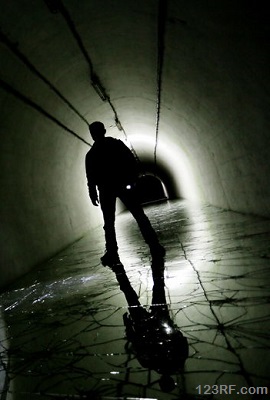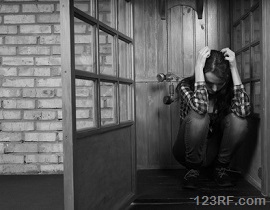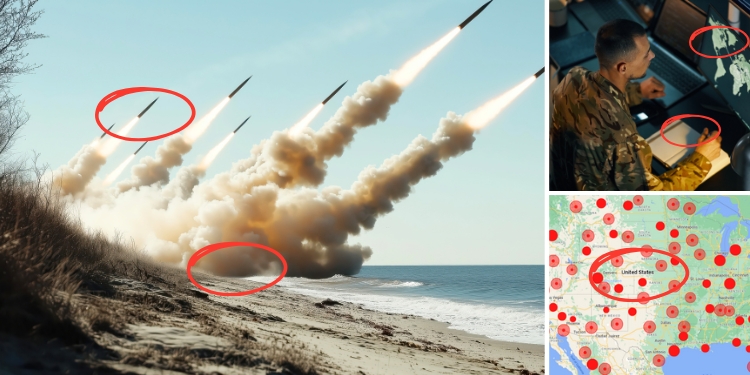When it comes to a social collapse based on a nuclear crisis, mushroom clouds created during a ground based incident may well come to mind.
Even though most people think they know what an exploding nuclear device may look like, there are actually many sources of based nuclear contamination. Each source of nuclear material will cause different visual, auditory, and other effects.
Therefore, when it comes to preparing for a nuclear incident, you must be aware of where the radiation will come from as well as how to deal with it as safely as possible.
The Air Based Nuclear Incident
Oddly enough, even with a full scale hostile detonation of a nuclear device, you may first need to recognize that an incident has occurred.
Consider a situation where a 1 kiloton bomb exploded in the air 30 or 40 miles away. Chances are, you would not even hear the blast let alone see the cloud rising up. Unfortunately, streams of radiation will already be headed your way. Even though they may not deliver lethal doses of radiation, you may still suffer from burns and mild to moderate radiation sickness if you are outdoors.
Since an air based explosion may well trigger an EMP, your first indicator may be that your car or cell phone stops working. If you are indoors, do not go outside to see if you will get a better reception.
Instead, ask others if their cell phones are working. If everyone seems to have lost service, stay indoors and head for the basements and lower levels as quickly as possible.
Without communications and information about where the blast has occurred, you could be running deeper into the radiation belt. You are better served by putting as much concrete and dirt between you and the fallout as you can. Needless to say, if you are in a vehicle, get into a building and to the lower levels as quickly as you can.
Once you reach a suitable shelter, follow the usual routine of squatting facing a wall with your forehead resting on knees and arms shielding the back of your neck. If you have Potassium Iodide and other cellular shields on hand, be sure to take those.
An air based nuclear incident will spread contaminated material further, and since air tends to be much lighter than dirt and ground based debris, it may also take longer for it to finish falling to the ground.
In small scale, relatively localized scenario, it is likely that you can get medical attention and reasonable care without fear of larger plans and complex scenarios. You may also be given information about where you can pick up Potassium Iodide tablets and other cellular shields.
With regard to air based nuclear explosions, your first few days will primarily be concerned with coping with radiation sickness, finding food, finding water, and washing as much radioactive material from your body as you can.
You will more than likely find it harder than usual to travel because cars will literally be stopped in the streets. If you have to leave a city, try to do so using underground subway, storm water, and old tunnel systems.

It is also important to realize that tunnel systems and subways may be shut off by government agencies that want to prevent nuclear waste from getting into underground chambers. Whether they know of your presence or not, you may simply become collateral damage because they feel the “big picture” they have been trained to uphold is more important.
And if you are planning to leave an area, be prepared to travel 5 – 6 times the distance that you would travel to get out of the radiation bands created by water and ground based nuclear incidences.
The Nuclear Detonation on the Ground
Over the years, prevailing views on what to do during an attack have changed. In particular, older advice revolved around staying in place and trying to get as far below ground as possible. Today, most experts say that you have approximately 1/2 hour after a blast to reach a place of safety. Instead of staying in place, you should use that time to get as far away from ground zero as possible. This makes sense if you are in a mid to outer area of the incident site.
Depending on how fast you travel, it may be possible to get into a less dangerous band, or away from the problem altogether. Once you reach the 20 – 25 minute post incident mark, you will need to take cover and then stay in that location for at least 24 hours, after that time the worst of the radiation will be dispersed. You may want to stay an additional 2 – 3 days depending on supplies and the durability of your shelter.
When you cannot get to a shelter, any standing object will have to do. Make sure that your shield is between you and the explosion point being affected by the nuclear blast so that it will absorb as much radiation as possible. If you think about how shadows work, then you can readily understand why your position in relation to the blast is so important.
Never look at the flash from a nuclear explosion as it can cause blindness in less than a second. Individuals living in cities or areas with larger populations can also try taking refuge in subways, sewer systems, and any other areas where there is plenty of concrete, brick, or dirt to absorb the radiation.
Once you reach the shelter, squat down on the floor as far away as possible from windows, doors, and beams. Sit so that you are facing a main wall and put your head on your knees. Use your hands and arms to shield your neck. Look downward as much as possible. If you look upward, your eyes may be blinded by the flash from any detonation that happens to occur.
Unfortunately, there are many situations where you may be stuck outside and have no shield or building to hide in. The best thing you can do is get as close to the ground as you can. If the ground is soft, then dig with rocks or your hands to get as far into the ground as possible. While you are working, do not look at the incident site.
During the first few hours, you are very likely to experience heavy winds and thermal blasts. The thermal blasts can set just about anything on fire as they pass.
Keep non-flammable, white or silver heat shields on hand. Put those on to try and keep as much heat as possible away from your body. As you work, also be aware that objects from miles away can easily strike you. Should concrete or something else suitable land nearby, do not take shelter behind it unless you know that it is not contaminated by radioactive debris.
If you receive warning of a pending nuclear blast, and you are indoors, you will need to get underground or into a basement as quickly as possible. Brick and cement structures will absorb the most radiation, so they are likely to offer the best shelter. Just remember to put as many walls or as much dirt as possible between you and the explosion point.
Always aim to be as close to the ground or below it as possible. Needless to say, if you are building a homestead, you can always insulate walls with dirt and lead, or just build your home as far underground as possible.
No matter whether you are indoors or out, it is very important to limit the amount of dust that gets into your nose, mouth, and on your skin. While a dust mask will be of immense benefit, even a handkerchief over your nose and mouth is better than nothing.
 You should also cover up your skin as much as possible using white or the lightest colors possible. Remember that black and dark colors will absorb radiation. This, in turn, can easily lead to burns on parts of your body where the darker colors were covering.
You should also cover up your skin as much as possible using white or the lightest colors possible. Remember that black and dark colors will absorb radiation. This, in turn, can easily lead to burns on parts of your body where the darker colors were covering.
You should also carry Potassium Iodide, Vitamin C, and Vitamin E tablets with you at all times. Take them as directed on the bottle as soon as you learn of a nuclear blast in your area. This medication will protect your thyroid from uptaking nuclear materials.
Typically, the thyroid is the first organ that determines how sick you will get from the radiation. One small pill can truly make the difference between serious radiation sickness and death even if your exposure levels are in the upper ranges.
You can obtain free Potassium Iodide tablets and instructions for taking them if you live near a nuclear power plant. Representatives in charge of readiness for nuclear emergencies in these areas may also have the tablets available for free. While these tablets may not be recommended for “prophylactic” or daily use, having them with you at all times is extremely important.
Just make sure that you follow dosing instructions because taking too much Potassium Iodide can poison the thyroid. Use iodized table salt or Himalayan Salt before nuclear blasts to ensure you are getting enough iodine in your diet. It should be noted that Vitamin C and Vitamin E can also shield other cells from some radiation damage.
Typically, radiation sickness will start within the first few hours after exposure to nuclear radiation. If you are not dealing with a detonation or large scale crisis scenario, it is very important to get medical attention as quickly as possible.
When it comes to a larger scale nuclear crisis, you will need to take a shower as soon as possible after the blast. Use soap that does not contain conditioners or oils that prevent dust and radioactive debris from being washed away. If you have scissors it may be of some use to cut your hair.
Shaving after a shower can also help get rid of some debris. Just take extra care to avoid razor burn as you don’t want to embed more radioactive material into your skin. Follow up with another shower using plenty of soap and water. If you have plenty of water pressure and water, then go ahead and shave while you are washing.
Do not put old clothes back on. Try to get rid of them so that you do not have radioactive materials in your living space. This includes getting rid of shoes, jewelry, weapons, and anything else that you were wearing during the incident. Once you are ready to leave the shelter, it will be time to think about long term survival. You may need to get medical attention or find your way out of the area.
It is fair to say that anyone growing up during the Cold War era is very aware of nuclear power, nuclear war, and all the chaos that it can bring. Regardless of your age, knowing how to survive both hostile and non-hostile releases of nuclear material are extremely important.
Never overlook the hazards associated with nuclear medicine, nuclear power plants or other industries just because they don’t make huge mushroom clouds or kill in a matter of moments. In fact, the slow, hidden damage and death from these sources may be far worse and far more troublesome than a nuclear war.
As you learn more about the daily hazards of exposure to land based nuclear radiation, you may well conclude that you need to be as prepared for these issues as you would be for a full blown war situation.
The Nuclear Incident on Water
If you happen to be swimming, in a boat, or otherwise in the water during a nuclear event, your first task will be to head for land. Depending on your distance from the explosion, you may only have a few minutes to half an hour to reach land and find suitable shelter.
During your escape from the explosion site, try to put anchors made of lead or brick between your body and the explosion. If possible, squat down and cover yourself with plastic or anything else that will keep water from seeping through your garments and onto your skin. The plastic should also be thick enough to prevent as much water vapor as possible from seeping in.
You should also have a mask on hand that will allow you to breathe without absorbing steam or water vapor into your lungs. While these aides will not stop radiation from passing through your body, it will limit the ability of radioactive debris from binding to your skin. This, in turn, will make it easier to wash the debris away later on.
As with land based explosions, you should always have Potassium Iodide tablets on hand. Take one as soon as you know an explosion or other event has occurred. If you are in marine or brackish waters, this precaution is even more important because these bodies of water may have higher levels of iodine in them.
As radiation moves out from the initial incident area, it will contaminate iodine present in the water. This iodine, in turn, can be quickly absorbed by the thyroid. Since the half-life of most iodine isotopes is under 10 days, you may need to take the potassium iodide tablets for a few weeks if you are exposed to a water based nuclear incident.
This may be distinctly different from land and air based explosions where the nuclear material may not produce as much iodine, or lower amounts are available to contaminate.
It should be noted that Potassium Iodide is not recommended for prophylactic treatment unless you are directed to do so during a nuclear power plant leak or there is other creditable reason to believe that some type of nuclear strike is going to occur in a matter of minutes or hours.
If you want to protect your thyroid from radioactive iodine before an event, simply make sure that you are getting enough iodine in your diet. Even though most people consume large amounts of table salt, there is also a high tendency towards deficiencies in the diet.
During a nuclear explosion or active leak scenario, radiation in the form of heat and light will be absorbed more readily by dark or black colors than white and light colors. Therefore, it is very important to keep white tarp, or even white bed sheets on hand to cover yourself with. If land is involved in the blast, this one minor thing may save you from more serious burns.
Once you reach land and a safe location, it is very important to shower. Make sure that you use soap and shampoo that do not contain skin conditioners, softening oils, or hair conditioners. All of these chemicals will only make it harder to wash radioactive materials away from your body.
You should also dispose of all contaminated clothing and jewelry. While this may be difficult, remember that even a single spec of dust can be radioactive for thousands of years and wreak mayhem during that time.



No comments:
Post a Comment